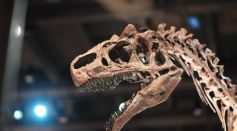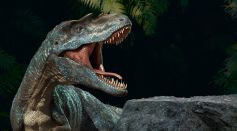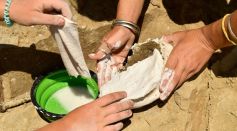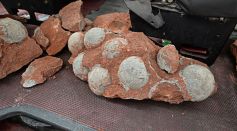Tags: Dinosaur

High-Tech Analysis on Dinosaur Fossils Could Tell Humans How to Live Sustainably, Deal With Current Climate Change

Dinosaur Discoveries in 2021: Which Prehistoric Fossil Finds About the Extinct Reptiles are the Most Unique This Year

Dinosaur Footprints Discovered in Wales, Imprint Made By 200-Million-Year-Old Triassic Sauropod

Real-Life Jurassic Park Possible? Experts Say Dinosaurs Can Be Recreated From Their DNA

Rare 130-Million Year Old Dinosaur Fossil Egg With Curled Up Embryo Similar to Unhatched Chickens Still Complete Inside Shell
Dinosaur Skeleton Unearthed: Scientists Say the Missouri Discovery Belongs to the Hadrosauridae Family
Dinosaur Species Belonging to the Famous Iguanodon Group Found in the Isle of Wight; Uniqueness of Feature Identified in Teeth Count
Modern-Looking True Crabs Discovered in Tree Amber; Study Reveals This 100 Million-Year-Old Fossil Rewrites Crustacean History
Dinosaur Cloning Might Become Possible: First Healthy Prehistoric DNA Was Found in a Perfectly Preserved Fossil in China
‘Dinosaur Shrimp’ Discovery in Northern Arizona; Unusual Finding of Hundreds of Tadpole-Size Creatures After Heavy Rainfall
Dinosaur Species Found in Brazil; Paleontologists Claim They Could Have Roamed the Country 70 Million Years Ago

Dinosaur Species Discovered: Paleontologists Announce Finding of Horned Crocodile-Faced Hell Heron from the Spinosaurid Group
160 Million Years Old Ankylosaur Grow Spikes From Its Ribs, Oldest-Known Dinosaur Features Body Armor
Tyrannosaurus rex Could Be Picky Eater; Did Jurassic Park Depict These Dinosaurs Wrongly?
Tennis Ball-Size Giant Turtle Egg Opened for the First Time to See the Rare Embryo Undisturbed for 90 Million Years
Science 'Facts' You Might Have Learned in School That Are No Longer True – For Now
Ancient Bird Skull has Similar Features with a T.Rex, Unearthed in China
Australia's Largest Dinosaur Ever Found Joins the Elite Group of Titanosaurs Only Found in South America
Giant Dinosaur Skeleton Discovered in China 70-Percent Complete; Paleontologists Say This 26-Feet Jurassic Find is 180 Million Years Old
Tyrannosaurs' Mass Death Site in Utah Shows These Dinosaurs Are Social Eaters
Most Popular

Orionids Meteor Shower Happening Next Week: Where and When To Catch the October Light Show's Peak

Texas Official Shot Down Siren Flood Alert, Complaining That It Might Go Off 'In the Middle of the Night': Report

Nvidia's Jetson Thor Could Make Humanoids Smarter Than Ever

Hellfire Missile Video Reveals MQ-9 Reapers Being Used for Aerial Combat





